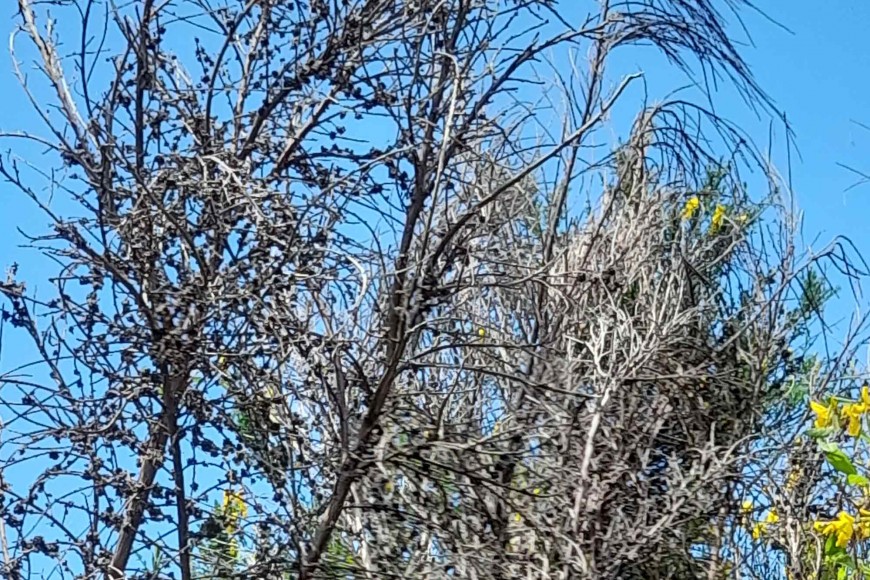How Damaging is the Broom Gall Mite?
“The invasion of broom in and around Tongariro National Park (TNP) has been quite frightening,” said Senior Technician Paul Peterson. “The flora in TNP is well adapted to low-fertility soils, and so it is particularly vulnerable to invasion by nitrogen-fixing plants such as broom,” he added. Nitrogen-fixing plants have a symbiotic relationship with bacteria that convert or ‘fix’ nitrogen from the air, adding it to the soil in a form available to plants. This alters the soil chemistry to the detriment of some native ecosystems with organisms adapted to low-nutrient soils, such as in TNP. Thus, the demand for effective control measures for broom to preserve this ecosystem is high. The Department of Conservation is using chemical control methods to slow the invasion of TNP by broom from adjacent infested areas that are currently unmanaged, but this is costly, and probably not sustainable in the long term.
Enter the broom gall mite (Aceria genistae) which was first introduced into NZ for biocontrol of Scotch broom in 2008. The mite spread rapidly throughout the South Island and soon started to cause visible damage to large stands of broom. Mites feed on the sap of developing buds, which results in the formation of galls (a swelling or growth) instead of new branches or flowers. The galls also act as ‘nutrient sinks’, diverting resources that would otherwise have been invested in new growth. According to weed scientist Simon Fowler, the impact of the broom gall mite started to become apparent about 10 years after its introduction, clearly slowing plant growth rates and in some cases killing whole stands of broom.

Dead broom from gall mite damage
Damage by the mite was particularly evident in the South Island, where it dispersed and became widespread very quickly. This presented an opportunity for Paul and colleagues to monitor the impact of the broom gall mite in the lower North Island, where the mites had been slower to establish and spread.
“We set up a field experiment to quantitatively measure the impact of the mites,” explained Paul. “Our impact assessment studies initially involved the exclusion of mites from plants to compare their growth with plants exposed to attack by the agent. However, an attempt to protect broom plants from mite attack at a site in the South Island failed, so it was decided a new tack was needed,” he added. Thereafter, a low maintenance study was set up by tagging 100 broom plants growing on the roadside between Palmerston North and TNP, and between Palmerston North and Hastings, in late 2016 and early 2017. Stem diameters of each plant were measured, and a mite release was randomly added to half of the plants, while the other half were left as controls (no mites were released onto them).
During 2021 and 2022 final stem measurements of the tagged plants were taken. Unfortunately, due to roadside maintenance, slips, and spraying and cutting, only 34 of the original 100 tagged plants were still available for the final measurement. For the remaining plants, the results showed that plants that received a mite release were more likely to die and grew more slowly than broom plants that did not get a release of the gall mite. Nevertheless, the impact of the mite on plant survival and growth rate was lower than expected, possibly because some of the plants that received mite releases failed to produce galls. Also, some control plants were eventually colonised by mites from nearby plants, reducing our ability to quantify impacts on the experimental plants.
Interestingly, the plants that received mite releases but did not produce galls were still less likely to survive and had slower growth rates compared to the control plants. In the past, broom plants have been reported to look stressed or to have some of their branches die following a release of the mite, despite not producing any obvious galls. There are two possible explanations for this: the mites inflict damage to the plants before dying out, which facilitates secondary infections by pathogens; or the mites damage the plants and remain present, but the plants are resistant to producing galls.
Despite the variable and limited results from this study, it is clear the broom gall mite is reducing the growth rate and survival of Scotch broom in NZ. This is good news for regions of the South Island where broom is a significant weed, and for areas such as TNP, where uncontrolled invasion could quickly transform this ecosystem to the detriment of many native plant species specifically adapted to local conditions.
Key contact

